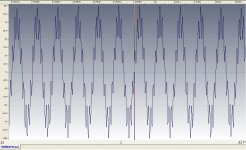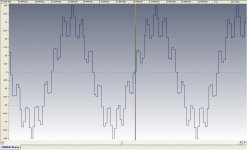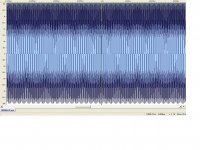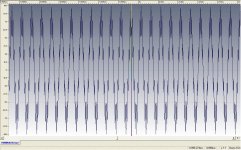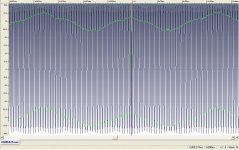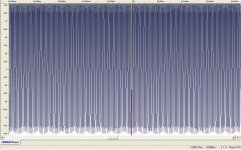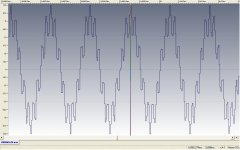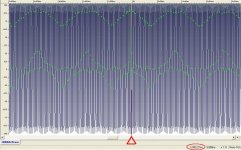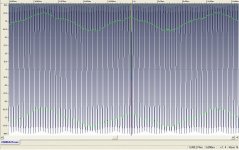Seems like a mono recording, 2 tones ~ 1kHz and ~8kHz. I guess there are some more peaks above 20kHz (I bet that there is one more main tone).
What worries me is that I can’t hear the amplitude modulation (useless ears) 😡
Regards
George
A brave soul with accurate but incomplete results!
It is 1 K and 9 K at 10/1 but there is a change 1/2 way through!
A brave soul with accurate but incomplete results!
It is 1 K and 9 K at 10/1 but there is a change 1/2 way through!
He He
I was quite curious myself
Going to full zoom (down to 23us step), I checked the repetition pattern.
I checked 4 complete periods of the main frequency (~1kHz).
The pattern on each period is almost the same , but not exactly the same.
Working with time period and converting to frequency, I noticed the following:
The main frequency components are : 1002Hz, 8849Hz and 8772Hz.
The (much) weaker frequency components are 11111Hz, 10989Hz, 2339Hz, 2140Hz and 77.6Hz. These may be intermodulation products or/and folding back components from the digitization process.
May be it is this "change 1/2 way" (the meaning of which escapes me😕) that produces the difference btn my findings and your two frequency components.🙂
Regards
George
It should be 1K and 9K at 10/1 with the 9K 15 degrees before the 1K until 1/2 way when it changes to 15 degrees after!
How did you capture it? And is there an error in the compression expansion process? I could not just post a .wav file.
How did you capture it? And is there an error in the compression expansion process? I could not just post a .wav file.
Listening to the file I would say its a distorted 1k and a distorted 9k, about half way down a close to 9.5k click.
Listening to the file I would say its a distorted 1k and a distorted 9k, about half way down a close to 9.5k click.
The click is the switch from phase shift before to phase shift after. The sin waves should be undistorted.
It should be 1K and 9K at 10/1 with the 9K 15 degrees before the 1K until 1/2 way when it changes to 15 degrees after!
How did you capture it? And is there an error in the compression expansion process? I could not just post a .wav file.
How did you capture it?
I unzipped what you posted and then I opened the unzipped wave file with Steinberg Wavelab 4.
And is there an error in the compression expansion process? I could not just post a .wav file.
The unzipped wave file has a duration of 3s998.050ms exact. Please check the exact duration of your initial wave file.
It should be 1K and 9K at 10/1 with the 9K 15 degrees before the 1K until 1/2 way when it changes to 15 degrees after!
OK!
This 30 degrees delta phase may do some of the harm.
Watching the “glitches”, I can tell that the amplitude ratio is around 10/1. (Visibly, it varies from 7:1 to 11:1).
The attachments below show -with progressive zooming-the exact middle of the unzipped file (the vertical multicolour line is at 1s999.025ms)
Regards
George
Attachments
Last edited:
It would have been a good idea though, but impractical.
Excellent one imo, and very practical for a DIY person.
(in particular for those with extensive experience with kevlar prepreg plus vacuum injection)
The servo's impact greatly depends on the secondary selection level of the JFETs, no ?
Nothing wrong with minimal feedback. Seems like it would be more accurate to describe the Blowtorch as having minimal audio feedback, rather than "no feedback." Considering all of the misguided discussions of feedback and whether it is good or bad (in general or in specific cases), I would personally prefer accurate descriptions.Of course, the servo operates below 1 Hz, AND the circuit operates perfectly fine WITHOUT the servo, except that there will be a little inherent offset due to the slight factory generated errors in the selected high current 2SK389-2SJ109 combination. The servo is deliberately 'detuned' to have the minimum effect possible on the audio path and have to 'work' even to obtain 0 offset, usually having about 2V or so at its output, for perhaps, correcting 10mV offset, total, or less.
P.S. I've been a fan of Parasound products for a dozen years or so, long enough to see products outlast their amazing ten-year warranties!
My FFT was clean over a 110dB range. I used a Houdy7 window.
See the inverse FFT of 1 sec of the first part and 1 sec of the second part.
I listened two both but they sounded similar to me.
See the inverse FFT of 1 sec of the first part and 1 sec of the second part.
I listened two both but they sounded similar to me.
Attachments
The click is the switch from phase shift before to phase shift after. The sin waves should be undistorted.
Ok, but I only listened to the file and it sounded distorted (using some crappy desktop loudspeakers) BTW the file "sounded" different before and after the "click"
I listened over the speakers in my ProBook, not very revealing......
What is it made for, the test signal ?
What is it made for, the test signal ?
RSDIO, I define Parasound products as having MINIMAL NEGATIVE FEEDBACK. The Blowtorch is essentially 'feedback free', at least by comparison.
Simon, tnx for this interesting experiment.
Listened to it over good speakers. No difference to my ears. Good illustration to me that absolute phase is not necessary for the pair I was born with.
May I suggest a slight modification for a second test, which I think might reveal the importance of relative phase. Would it be possible to post the same signal in stereo, with in the first half L-15 degrees and R+15 degrees, and then switched in the middle? I really hope that this could be done for two reasons: 1) curious what it will do, there might be something, and 2) if there is something, that would indicate that relative phase of frequencies > 5Khz still plays a role in positioning. Which would be interesting, because no phase information enters the brain above 3.5-5 KHz as such.
vac
Listened to it over good speakers. No difference to my ears. Good illustration to me that absolute phase is not necessary for the pair I was born with.
May I suggest a slight modification for a second test, which I think might reveal the importance of relative phase. Would it be possible to post the same signal in stereo, with in the first half L-15 degrees and R+15 degrees, and then switched in the middle? I really hope that this could be done for two reasons: 1) curious what it will do, there might be something, and 2) if there is something, that would indicate that relative phase of frequencies > 5Khz still plays a role in positioning. Which would be interesting, because no phase information enters the brain above 3.5-5 KHz as such.
vac
John,
To be honest, the EE and Accountant in me would BY FAR prefer if there where no differences, but reality has this way of disagreeing with what we would like to see.
I would add that our tests do not really add much to what has already been illustrated by the various articles extant regarding materials and constructions impact on distortion, memory effect (aka DA) and microphonics (the articles regarding this are in German so may be largely unknown outside germany) and their impact on sonics.
What I found interesting though is that for example capacitors with essentially identical construction and materials from different manufacturers that I had actually as for all intents and purposes interchangeable showed minuscule, but reliable identifiable differences leading to preferences for specific brands and against others. Funnily in sighted testing (arguably much more casual testing) previously I had missed these differences...
Ciao T
Well, Thorsen, at least you are FINDING differences in caps. I would certainly hope so.
To be honest, the EE and Accountant in me would BY FAR prefer if there where no differences, but reality has this way of disagreeing with what we would like to see.
I would be afraid to discuss caps here the way Charles Hansen and I do, over the phone. In fact, it would tick off Charles if I did, as we have our 'trade secrets' too! So much for 'all caps sound the same'. That is for double blind tests to show, not our ears.
I would add that our tests do not really add much to what has already been illustrated by the various articles extant regarding materials and constructions impact on distortion, memory effect (aka DA) and microphonics (the articles regarding this are in German so may be largely unknown outside germany) and their impact on sonics.
What I found interesting though is that for example capacitors with essentially identical construction and materials from different manufacturers that I had actually as for all intents and purposes interchangeable showed minuscule, but reliable identifiable differences leading to preferences for specific brands and against others. Funnily in sighted testing (arguably much more casual testing) previously I had missed these differences...
Ciao T
Charles and I often use Reliable RT polystyrene caps. I use them for Vendetta, Parasound, and Constellation. I find them better than anything else within their range for EQ and power supply bypass. Sometimes, I use Teflon from the same manufacturer. It is difficult to determine whether Teflon is really better, both subjectively and by measurement. We normally use polypropylene for larger values.
And winner is....Mundorf!! 🙂reliable identifiable differences leading to preferences for specific brands and against others
The click is the switch from phase shift before to phase shift after. The sin waves should be undistorted.
My FFT was clean over a 110dB range. I used a Houdy7 window.
See the inverse FFT of 1 sec of the first part and 1 sec of the second part.
I listened to both but they sounded similar to me.
I can not perceive any acoustic difference between the two parts of the file. That’s good. It makes me immune to phase difference issues 😛
Alas, I can hear a faint click in the middle of the file.
I spent a lot of time viewing the waveform to spot any sign of a “click”. There is no such sign. I was positive on this. But I was hearing the click.
I changed sound card, amplifier, headphones. I kept hearing it.
Is this “click” generated in my ears/brain?
Today I viewed the waveform again. Maybe 😀 it is the morning coffee and the cigarettes that made me see a pattern change -at a specific only zooming level- in the middle (almost) of the file, at 1s 999.27ms.
Attached you will see snapshots of the specific location.
Attachment 2 and 3 are the only zooming levels that the pattern visibly differentiates.
Regards
George
Attachments
On the two attachments I have marked this pattern with green spots to highlight what I mean with pattern change.
I still wonder if this is what makes me hear the click.
The peak at 1s 999.27ms is ~ 40ms away from the previous and the next peak. The previous and the next peaks which are similar to all the rest, are ~80ms apart.
I’ve read that the brain needs around 50ms to form the timbre quality of a sound. Shorter stimuli are perceived as clicks. Is this what happens here?
Regards
George
I still wonder if this is what makes me hear the click.
The peak at 1s 999.27ms is ~ 40ms away from the previous and the next peak. The previous and the next peaks which are similar to all the rest, are ~80ms apart.
I’ve read that the brain needs around 50ms to form the timbre quality of a sound. Shorter stimuli are perceived as clicks. Is this what happens here?
Regards
George
Attachments
My FFT was clean over a 110dB range. I used a Houdy7 window.
See the inverse FFT of 1 sec of the first part and 1 sec of the second part.
I listened two both but they sounded similar to me.
Joachim
The RMAA 5 refuses to open the wave file that Ed Simon posted. I don’t know why.
So I can not perform a proper FFT on it.
What I reported as frequency components is based on manual transformation from time domain to frequency domain, watching and marking the different waveforms -37 points-from a small part of the file (from 0.249ms to 4.240ms).
Not a long strip of the waveform, but this method is very cumbersome ( I tried it only in lieu of an FFT).
What is the time difference between the two bell shaped peaks on your inverse FFT snapshot?
Regards
George
Last edited:
- Status
- Not open for further replies.
- Home
- Member Areas
- The Lounge
- John Curl's Blowtorch preamplifier part II
